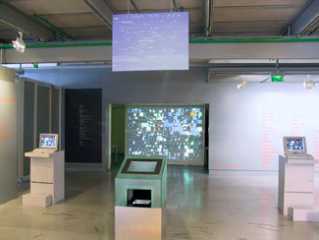Dateien
Technische Beschreibung
The public contributes a digital image and description of an object they carry with them at the time of the exhibition.
- The description is entered through a questionnaire
- This data is stored in a database that grows during the life of the exhibition
- The data is then organized by an algorithm that groups the objects according to proximity based on their descriptions
- The algorithm is titled a "self-organizing map" and its function is to map out in a 2 dimensional space the relative closeness of each object to the group based on their properties
- The spatially organized map is then projected on a large wall in the gallery space and can also be viewed on the internet.
- The public can explore and view the data for each object and related objects through terminals placed in the exhibition space.
- Audiences both in the exhibition and on the internet, can additionally contribute by adding comments and stories to the objects.
- The archive of objects, in the end, also becomes a site for the collection and exchange of stories.
The self-organizing map was produced in Helsinki by Dr. Timo Honkela and his team from the Media Lab (University of Helsinki) working in neural-net based algorithms.
"The Self-Organising Map (SOM, also called Kohonen map) algorithm is the basic method that is used to create the "wall of memories". The SOM organises the input items into an ordered display, a 2 dimensional map. On the map two items tend to appear close to each other if they have similar input features.
In the exhibition, the input features consist of some attributes and keywords. The attribute values and keywords are given by the exhibition visitor.
They are transformed into numerical form that can serve as inputs. The algorithm may start from a random state of the map. Through the process of iteratively (repeated recalculation) handling the inputs it reaches an ordered state.
The map consists of a collection of map nodes that can be thought as places on the map landscape. On the map, nearby nodes tend to have similar items.
Close to each there may be items that have been given similar attribute values, or items that have been named similarly. Thus, all the items with a particular keyword are not necessarily next to each other if the other features vary. Moreover, even if the visual qualities of an image are very similar, it may very well happen that two persons evaluate the item very differently based on their subjective point of view. There are also cases in which even the neighbors are rather far from each as there are occasionally dividing valleys and mountains ranges also in the natural landscapes.
The order of the final map is a consequence of all the inputs. The phenomenon is called emergence: the order is not determined beforehand. The order emerges through the audience contributions. The classification system is not specified by hand but it is created through the large number of local interactions on the map. This is why the system can be called 'self-organizing'. Metaphorically, similar items look for each other without any centralised command.
The principle of the SOM was developed originally by academician Teuvo Kohonen. The inspiration for this innovation has stemmed from the numerous neurophysiological studies in which it was shown that in the cortex of the brain similar kind of maps can be found." (Timo Honkela)
Technical comment on the Self-Organizing Maps and their first implementation (Media Lab group):
- For generation of maps we used sompak reference inplementation, which can be obtained freely from Helsinki University of Technology, where SOM's were invented.
- Feature vectors consisted of simple scalar values obtained from straight from visitors input with rather long section wich was delivered from the textual input by random vector mapping introduced by Mr. Honkela in his doctoral thesis, which is available from net.
- For the labelling of the map we developed a new tool to avoid overlapping of images and to give emphasis on fresh entries.
- There were no sophisticated databases implementations on our part, everything (maps, input data, dictionary for random vectors ) was stored in textfiles and managed by bunch of perl-scripts.
In the end, and in contrast to the original plans, the work (visual image, interactivity, etc.) was quite a compromise:
- Projection was rather small in physical size and contained small number of items.
- Planned PDAs with wireless connection for visitors which would allow individual exloring of the map and annotation of objects with stories or "memories" was dropped.
- I didn't check out how well different objects finally organized.
(Timo Koskenniemi)
Hardware / Software
2 to 4 screen projections, scanning station, 2 terminals, wall design
In 2003, PFOM I was updated to PFOM II: a digital scanning of objects replaced the former analog video scan and moreover the visualization was changed to 4 views: the image of the objects, a textual description of the each object, the movement of objects on the screen as they get organized, the u-matrix cluster mapping of the SOM algorithm which shows how the SOM organizes the objects in groupings.


